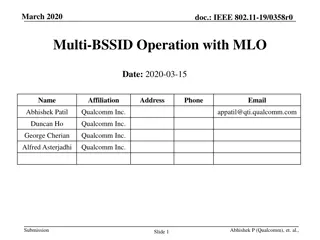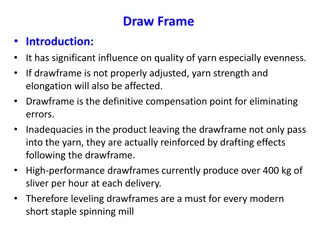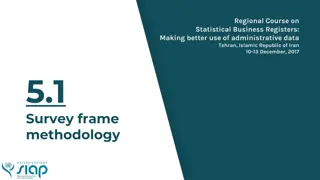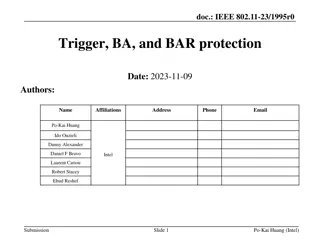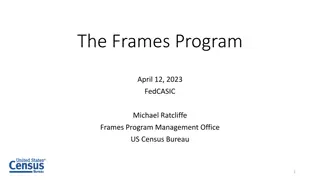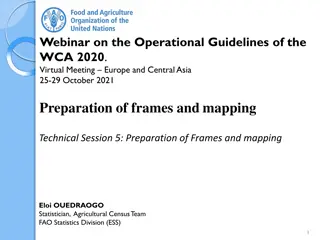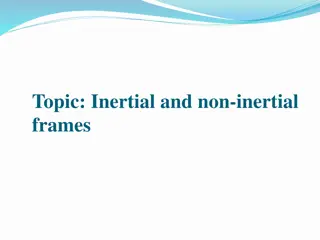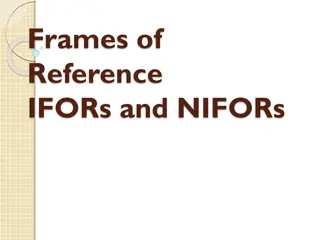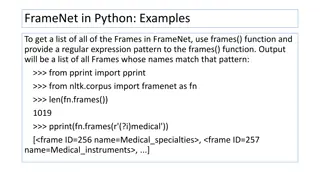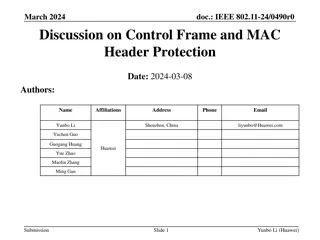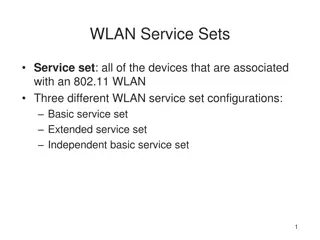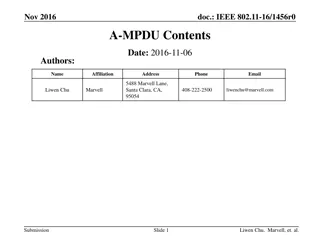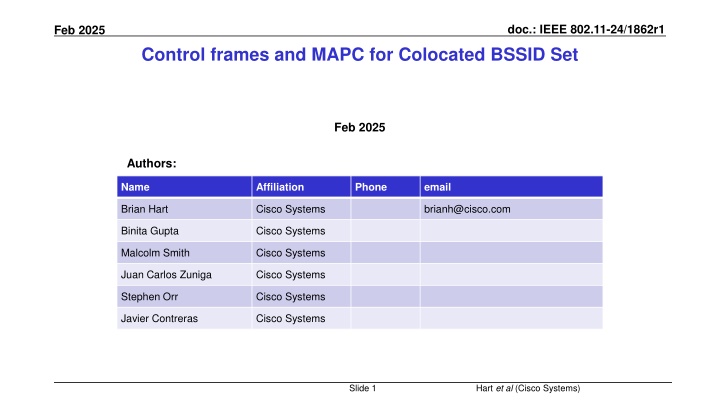
Understanding IEEE 802.11-24/1862r1 Control Frames and MAPC for Colocated BSSID Set
Explore the intricacies of Multiple BSSID Set and Co-hosted BSSID Set within the IEEE 802.11-24/1862r1 standard, focusing on control frames and MAPC. Learn about the signaling, features, and differences between these BSSID sets, as defined by industry experts from Cisco Systems. Dive into the technical details of virtual APs, BSSs, and beacon sharing/compression, shedding light on the evolving landscape of wireless networking technology.
Download Presentation

Please find below an Image/Link to download the presentation.
The content on the website is provided AS IS for your information and personal use only. It may not be sold, licensed, or shared on other websites without obtaining consent from the author. If you encounter any issues during the download, it is possible that the publisher has removed the file from their server.
You are allowed to download the files provided on this website for personal or commercial use, subject to the condition that they are used lawfully. All files are the property of their respective owners.
The content on the website is provided AS IS for your information and personal use only. It may not be sold, licensed, or shared on other websites without obtaining consent from the author.
E N D
Presentation Transcript
doc.: IEEE 802.11-24/1862r1 Feb 2025 Control frames and MAPC for Colocated BSSID Set Feb 2025 Authors: Name Affiliation Phone email Brian Hart Cisco Systems brianh@cisco.com Binita Gupta Cisco Systems Malcolm Smith Cisco Systems Juan Carlos Zuniga Cisco Systems Stephen Orr Cisco Systems Javier Contreras Cisco Systems Slide 1 Hart et al (Cisco Systems)
doc.: IEEE 802.11-24/1862r1 Feb 2025 Situation (1/4) In 802.11, Colocated BSSID Set = Multiple BSSID Set xor Co-hosted BSSID Set The same AP radio hardware supports virtual APs and virtual BSSs, typically one per SSID Common in the enterprise and now the home too (e.g., core devices + guest devices) These virtual BSSs make up a Colocated BSSID Set, as one of: Multiple BSSID Set Beacon + Probe Response frame sharing/compression Used predominantly at 6 GHz; harder to use at 2.4/5 GHz due to legacy xor Co-hosted BSSID Set Separate Beacon + Probe Response frames for each BSSID Predominant VBSS mechanism at 2.4+5 GHz due to legacy [1] Colocated BSSID Set Key: Multiple BSSID Set Co-hosted BSSID Set Transmitted BSSID (bold) APa xor APb APc APd APa APa APb APc APd APb Nontransmitted BSSID (normal) Slide 2 Hart et al (Cisco Systems)
doc.: IEEE 802.11-24/1862r1 Feb 2025 Situation (2/4) Both kinds of sets are identified via similar signalling Multiple BSSID Set [1] Both kinds of sets are identified via the number of variable LSBs of the BSSID E.g., If the virtual BSSs BSSIDs can take the form of 0x012345x (x = 0x0...0xf), with a max of 16 BSSIDs in the set, then this is signaled as n = 4 Co-Hosted BSSID Set [1] Slide 3 Hart et al (Cisco Systems)
doc.: IEEE 802.11-24/1862r1 Feb 2025 Situation (3/4) Enhanced Control frame features are confined to Multiple BSSID Sets 11ax and 11be features are consistently defined for Multiple BSSID Sets but erratically defined for Co- hosted BSSID Sets: Both Multiple BSSID Sets and Co-hosted BSSID Sets BSS Color ( 3.2 [1]) Intra-BSS and inter-BSS PPDU classification ( 26.2.2 [1]) Dual NAV ( 26.2.4 [1]) Non-SRG & SRG OBSS PD level ( 26.2.3, 26.10.2 [1]) PSR-based SR ( 26.10.3 [1]) Multiple BSSID Sets only Rx Control Frame To MultiBSS ( 9.4.2.247.2 [1]), which allows set-wide operation of: MU-RTS + CTS ( 26.2.6.3 [1]) NDPA + NDP ( 26.7.3 [1]) MU PPDU Trigger + TB PPDU ( 26.5.2.2.1, 26.5.2.2.4, 26.5.2.3.1 [1]) Multi-STA BA ( 26.4.1 [1]) HE dynamic SM power save ( 26.14.4 [1]) Slide 4 Hart et al (Cisco Systems)
doc.: IEEE 802.11-24/1862r1 Feb 2025 Situation (4/4) In reality, Colocated BSSID Set = Multiple BSSID Set xor Co-hosted BSSID Set is not true Since certain clients are challenged by Beacon frames with a higher number of octets, then a Colocated BSSID Set with a high number of SSIDs~BSSIDs~virtual APs is enabled via multiple MBSSID Beacons Basically, a co-hosted set of Multiple BSSID Sets But 802.11 has no language to account for this In 802.11, VBSSIDs are always one or the other Key: Transmitted BSSID (bold) APa APb Nontransmitted BSSID (normal) What IEEE says today: What exists in reality (especially at 6 GHz): Colocated BSSID Set Colocated BSSID Set Multiple BSSID Set Co-hosted BSSID Set MBSSID Set1 MBSSID Set2 xor APb APc APd AP1b AP2d APa APa APb APc APd AP2c AP1a Slide 5 Hart et al (Cisco Systems)
doc.: IEEE 802.11-24/1862r1 Feb 2025 Three Problems A. We re solving Co-TDMA across non-colocated APs So, we should also address the equivalent and easier! problem of Co-TDMA among colocated APs B. We have a sharing AP granting a portion of a TXOP via Co-TDMA to a coordinated AP But the TXOP grant and residue return should operate at the Colocated BSSID Set level, not the individual AP level (see also [2]) C. Overheads from 802.11 s xIFS and preamble means that MU+TB PPDUs are the key path to efficiency So aggregation across STAs, regardless of which BSS in a Colocated BSSID Set they are associated to, is an important efficiency we can leverage That is, we should extend the Rx Control Frame To MultiBSS feature-set Slide 6 Hart et al (Cisco Systems)
doc.: IEEE 802.11-24/1862r1 Feb 2025 Solution for Problem A (1/2) Use Co-TDMA to Serve All Clients of a Colocated BSSID Set in one TXOP Now, applying the Co-TDMA protocol directly to colocated BSSs leads to inefficiencies (and weirdness!) NAV MU-RTS TXS MU-RTS TXS AP1a ICF Intra- BSS1a PPDUs (TXOP holder) C1a Colocated BSSID Set TXOP return AP1b CRF CRF MBSSID1 Cohosted1 Intra- BSS1b PPDUs (chained NAV) C1b AP1b AP1a AP1c AP1d Note: no regulatory impediment to AP1b directly granting a portion of the TXOP to AP1c instead of a return to AP1a then grant to AP1c. Ditto AP1c to AP1d TXOP return AP1c CRF CRF C1b C1d C1a C1c Intra- BSS1c PPDUs (chained NAV) C1c AP1d CRF ICF+CRFis redundant for colocated APs; only needed for non-colocated APs C1d No need for AP1b to tell AP1b OTA that it is done MU-RTS TXS + CRF transmitted by the same radio that receives neither frame!? Hart et al (Cisco Systems) Slide 7 Ditto Ditto
doc.: IEEE 802.11-24/1862r1 Feb 2025 Solution for Problem A (2/2) Let Co-TDMA Serve All Clients of a Colocated BSSID Set in one TXOP but these can be optimized away, for a great efficiency improvement (Keep the chained NAV to avoid clients in BSS1b/c from sleeping during their BSS portion) NAV AP1a Intra- BSS1a PPDUs (initial TXOP holder) C1a Colocated BSSID Set AP1b Intra- BSS1b PPDUs MBSSID1 Cohosted1 (chained NAV) C1b AP1b AP1a AP1c AP1d AP1c C1b C1d C1a C1c Intra- BSS1c PPDUs (chained NAV) C1c AP1d C1d Hart et al (Cisco Systems) Slide 8
doc.: IEEE 802.11-24/1862r1 Feb 2025 Solution for Problem B (1/2) MAPC Grants Should be Between Colocated BSSID Sets not between APs Current proposals suggest that sharing AP1a should a grant portion of a TXOP to AP2a then AP2b via sequential grants: MU-RTS TXS(AP2a) + CRF + <grantedPortionAtAP2a> + TXOPreturn(AP1a) MU-RTS TXS(AP2b) + CRF + <grantedPortionAtAP2b> + TXOPreturn(AP1a) This has very high overheads Colocated BSSID Set 1 MBSSID1 Cohosted2 AP1b AP1a AP1c AP1d NAV C1b C1d C1a C1c MU-RTS TXS MU-RTS TXS AP1a ICF Intra- BSS1a PPDUs (TXOP holder) C1a Colocated BSSID Set 2 TXOP return AP2a CRF CRF Intra- BSS2a PPDUs (chained NAV) MBSSID2 Cohosted2 C2a AP2b AP2a AP2c AP2d TXOP return AP2b CRF CRF Intra- BSS2b PPDUs (chained NAV) C2b C2d C2a C2c C2b No need for AP2a to tell AP1a that it is done MU-RTS TXS + CRF transmitted by the same radio that receives neither frame Slide 9 Hart et al (Cisco Systems)
doc.: IEEE 802.11-24/1862r1 Feb 2025 Solution for Problem B (2/2) MAPC Grants Should be Between Colocated BSSID Sets not between APs The much more efficient solution is for grants and TXOP returns should operate at the Colocated BSSID Set level Still based on traffic priority, MAPC agreements, etc Colocated BSSID Set 1 MBSSID1 Cohosted2 AP1b AP1a AP1c AP1d NAV C1b C1d C1a C1c MU-RTS TXS AP1a As before, AP1a/b/c/d could directly use the next portion of the TXOP ICF Intra- BSS1a PPDUs (TXOP holder) C1a Colocated BSSID Set 2 AP2a CRF CRF Intra- BSS2a PPDUs (chained NAV) MBSSID2 Cohosted2 CRF can summarize AP2a/b/c/d C2a AP2b AP2a AP2c AP2d As before, no regulatory impediment to AP2a directly granting a portion of the TXOP to AP2b instead of a return to AP1a then grant to AP2b. TXOP return AP2b Intra- BSS2b PPDUs (chained NAV) C2b C2d C2a C2c C2b Slide 10 Hart et al (Cisco Systems)
doc.: IEEE 802.11-24/1862r1 Feb 2025 Solution for Problem C (1/3) High Level Explicitly signal the Colocated BSSID Set Via the number of variable LSBs in the BSSID, sent in the UHR Operation element (Similar to Multiple BSSID Set / Co-hosted BSSID Set signaling) Introduce the Rx Control Frame To Colocated BSSID Set field Use this to extend the Rx Control Frame To MultiBSS feature-set to all VAPs/VBSSs/VBSSIDs in the Colocated BSSID Set Wherever a feature is conditioned on Rx Control Frame To MultiBSS today, extend that condition, in the UHR draft, to be Rx Control Frame To MultiBSS = 1 or Rx Control Frame To Colocated BSSID Set = 1 Or similar, since the details are always a little more involved Assume all information (PM, DL buffer sizes, BSR, SCS(QC), etc) is shared among APs of a Colocated BSSID Set or leave anything out (with a sufficiently different BSSID) Colocated BSSID Set - can mix n match anything Multiple BSSID Set6 Co-hosted BSSID Set7 Multiple BSSID Set1 Multiple BSSID Set2 Co-hosted BSSID Set3 AP8 m AP4g AP5h AP6i AP6j AP7k AP7l AP1b AP2c AP2d AP1a AP3e AP3f Slide 11 Hart et al (Cisco Systems)
doc.: IEEE 802.11-24/1862r1 Feb 2025 Solution for Problem C (2/3) Need Colocated BSSID Set BSSID(s), analogous to Transmitted BSSID Rx Control Frame To MultiBSS feature-set uses the Transmitted BSSID when sending control frames for the entire Multiple BSSID Set. Something similar is needed for a Colocated BSSID Set Rx Control Frame To Colocated BSSID Set can go two ways: Option A: A Colocated BSSID Set has a single Colocated BSSID Set BSSID Complete aggregation & efficiency for UHR STAs, but certain legacy STAs can never participate Option B: A Colocated BSSID Set uses any (transmitted) BSSID in the set as a Colocated BSSID Set BSSID Complete aggregation & efficiency for UHR STAs + all legacy STAs have a way to participate Key: Participating UHR Non-AP STA Option B Option A All TXOPs Later TXOP Earlier TXOP Participating Legacy Non-AP STA Legacy Non-AP STA that can never participate Legacy Non-AP STA not participating in this TXOP Colocated BSSID Set Colocated BSSID Set Colocated BSSID Set X MBSSID1 MBSSID2 MBSSID1 MBSSID2 MBSSID1 MBSSID2 ~ AP1b AP2d AP1a AP2c AP1b AP2d AP1a AP2c AP1b AP2d AP1a AP2c Transmitted BSSID (bold) AP2a ~ ~ ~ ~ X X Colocated BSSID Set BSSID AP1a Slide 12 Hart et al (Cisco Systems)
doc.: IEEE 802.11-24/1862r1 Feb 2025 Solution for Problem C (3/3) Simplest if AIDs are unique across STAs of a Colocated BSSID Set Simplest if AIDs are unique across STAs of a Colocated BSSID Set Since then the STAID is unique too In a Multiple BSSID Set, the first 2n AIDs are reserved to indicate groupcast traffic in the TIM element in Beacon frames This is still only needed per Multiple BSSID Set no change Since the co-hosted BSSIDs and nothing BSSIDs still have their own Beacon frames Slide 13 Hart et al (Cisco Systems)
doc.: IEEE 802.11-24/1862r1 Feb 2025 Summary APs in a Colocated BSSID Set currently contend independently, and would benefit from Co-TDMA Yet naively applying the current Co-TDMA protocol to colocated APs leads to inefficiency (and weirdness) The natural solution is an optimized variant of Co-TDMA for APs in a Colocated BSSID Set that omits OTA communication between colocated APs When APs grant or return a portion of a TXOP to each other via Co-TDMA (or any resource via any MAPC technique), to minimize overheads, the grant or return should be at the Colocated BSSID Set level (if present) As well, we have a great opportunity for efficiency improvements via combining users across The multiple Multiple BSSID Sets at 6 GHz, and The Co-hosted BSSID Set at 2.4+5 GHz by enlarging the Rx Control Frame To MultiBSS feature to Rx Control Frame To Colocated BSSID Set MU-RTS + CTS, NDPA + NDP, MU PPDU, Trigger + TB PPDU, Multi-STA BA and HE Dynamic SM Power Save across all virtual BSSs Slide 14 Hart et al (Cisco Systems)
doc.: IEEE 802.11-24/1862r1 Feb 2025 Strawpoll 1 Do you agree to add the following text to the 11bn SFD: The 802.11bn draft shall define optimized Co-TDMA for colocated APs in a Colocated BSSID Set Y / N / A Slide 15 Hart et al (Cisco Systems)
doc.: IEEE 802.11-24/1862r1 Feb 2025 Strawpoll 2 Do you agree to add the following text to the 11bn SFD: The 802.11bn draft shall define how MAPC-related resource sharing can operate at the Colocated BSSID Set level Y / N / A Slide 16 Hart et al (Cisco Systems)
doc.: IEEE 802.11-24/1862r1 Feb 2025 Strawpoll 3 Do you agree to add the following text to the 11bn SFD: The 802.11bn draft shall define how a Colocated BSSID Set can be signaled The 802.11bn draft shall define how exchanges that involve control frames (namely MU-RTS + CTS, NDPA + NDP, MU PPDU, Trigger + TB PPDU, Multi-STA BA and HE dynamic SM power save) can include multiple STAs associated to multiple APs of the same Colocated BSSID Set Y / N / A Slide 17 Hart et al (Cisco Systems)
doc.: IEEE 802.11-24/1862r1 Feb 2025 References [1] 802.11REVme Draft 7.0 [2] 24/719 MAP set operation , Jay Yang Slide 18 Hart et al (Cisco Systems)
doc.: IEEE 802.11-24/1862r1 Feb 2025 Backup Slide 19 Hart et al (Cisco Systems)



